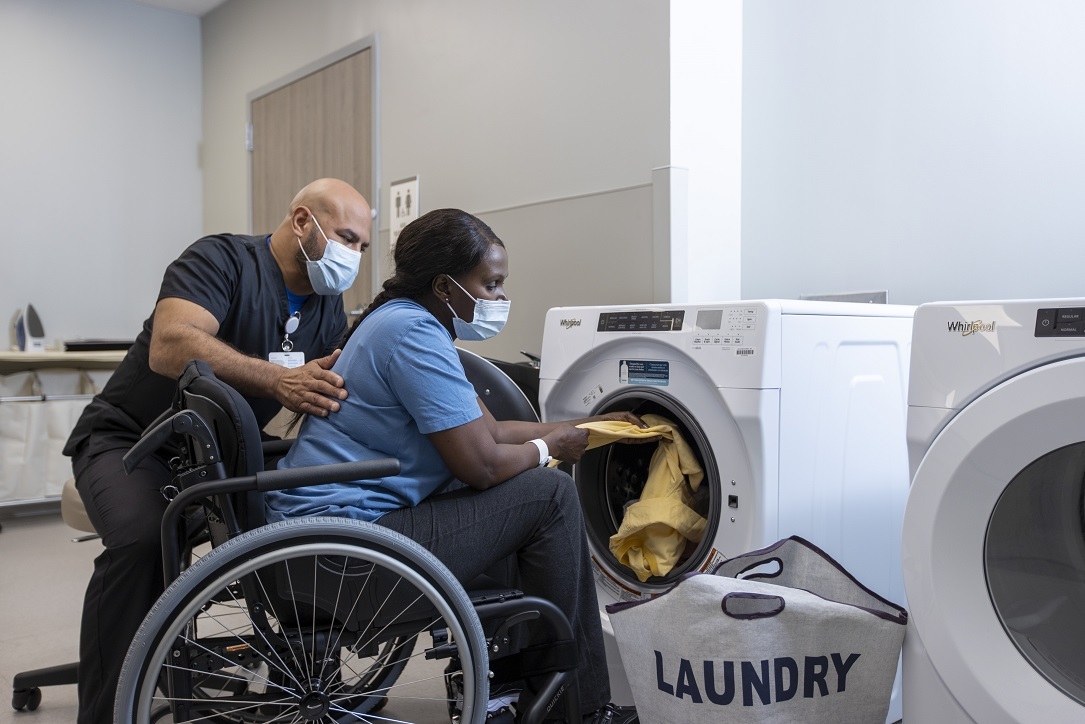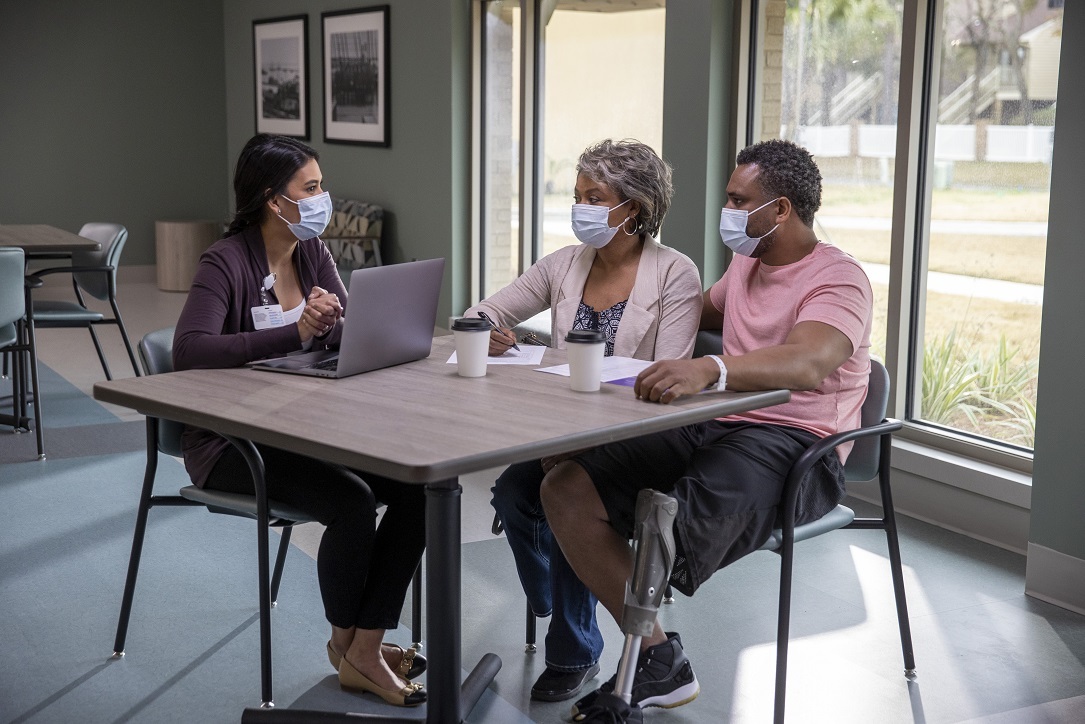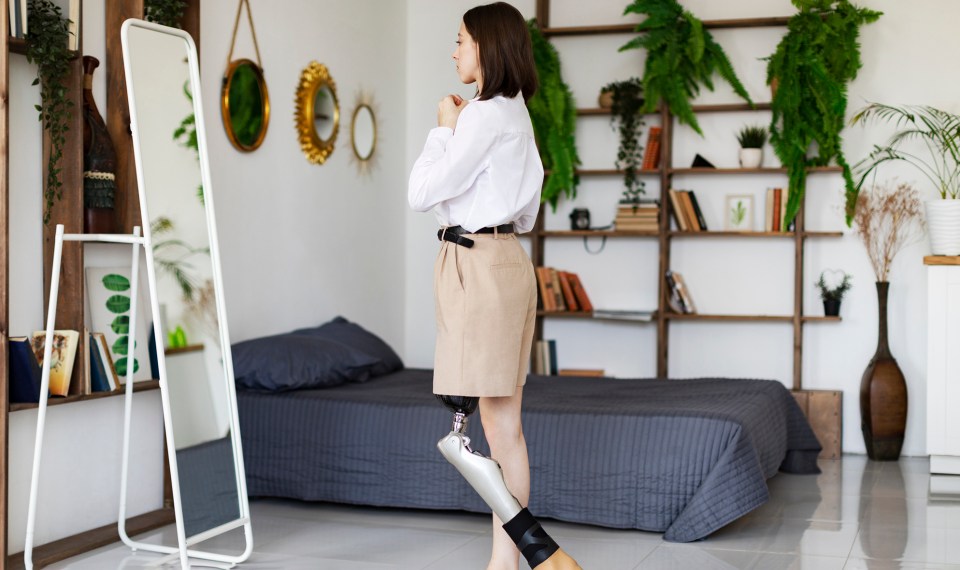Amputation is a life-altering event that affects every aspect of a person’s life. From handling the physical limitations limb loss has caused to adjusting to a new normal emotionally, they will need to take it slow and work with a support system to adjust to life after amputation.
Ron Holbrook, amputee program manager at Encompass Health Rehabilitation Hospital of Concord in New Hampshire, is dedicated to ensuring patients get the care they need after amputation. He says there are many factors that affect an amputee’s inpatient rehabilitation therapy, recovery time, life expectancy and home life.
Severity of Amputation Affects Recovery
The level of amputation is a key factor in recovery. “Someone who undergoes a toe or partial foot amputation will be able to get up and start moving around much easier than someone who undergoes a below or above the knee amputation,” Holbrook said.
The time frame to receive a prosthetic after an above or below the knee amputation is many weeks to months, whereas in many cases, a patient who has a toe or partial foot amputation is typically able to bear weight and walk more quickly after surgery.
Other Factors that Affect Recovery
Recovery time looks different from patient to patient. Other factors that affect healing include:
- Vascular disease: Someone who has vascular disease may have a longer recovery than an amputee who lost their limb due to trauma. Vascular disease can affect blood circulation, which affects how quickly an amputation wound will heal.
- Age: An older person will have a more difficult recovery than a younger one, according to Holbrook.
- Falls: A fall on a residual limb can also delay healing and reopen the wound. During inpatient rehabilitation, therapists will work with patients to reduce fall risk so the recovery timeline and and potential prosthetic training isn’t delayed.
- Motivation: “Some patients are highly motivated to get back to their day-to-day routines, while others have a more challenging time and struggle with limb loss,” Holbrook said.
- Physical condition: Patients with more strength, good balance, mobility and cognitive function will typically recover faster.
Life Expectancy after Amputation
The level of amputation also plays a significant role in life expectancy. Age and management of more than one medical condition such as type 2 diabetes and obesity all factor in to life expectancy.
According to Holbrook the average three-year survival rate after amputation is about 50 percent while the average five-year survival rate is 39-68 percent. Additionally, up to 55 percent of patients who underwent amputation as a result of medical conditions may require a second amputation within two to three years.
Fortunately, there are ways to extend life expectancy after amputation. If you are diabetic, developing healthy eating habits and a more active lifestyle can reduce the risk of health complications. You can also reduce risk of further amputation with daily skin checks, especially on your feet, continuing routine health care with your doctor and maintaining a strong support system.

Inpatient Rehabilitation for Amputees
Encompass Health clinicians work together to develop a customized care plan for each patient who comes to Encompass Health for inpatient rehabilitation. Patients can expect three hours of therapy each day, typically split between physical therapy and occupational therapy. This comprehensive care helps patients adjust to life after amputation so they can return to their homes, families and communities.
What to expect in physical therapy: Physical therapists have extensive expertise in helping patients regain mobility. In physical therapy at Encompass Health, patients will practice mobility tasks such as getting in and out bed, getting to and from a wheelchair, getting in and out of a car, standing up and sitting down.
Depending on the level of amputation, physical therapists may test the patient’s activity tolerance through short walks with a walker and stair climbing.
Physical therapists will also work with patients to reduce the risk of falls and teach limb protection techniques. Holbrook stresses the importance of education in physical therapy. “Learning the dos and don’ts of post-operative rehabilitation is vital,” Holbrook said. “Generally the goal is to work toward setting the patient up as best as possible to get a prosthetic if appropriate.”
What to expect in occupational therapy: Activities of daily living is the main focus of occupational therapy. Occupational therapists are skilled in helping patients regain their ability to perform tasks like dressing, bathing, toileting and grooming. Occupational therapists also focus on home safety. Using an activities of daily living suite at the hospital helps patients adjust to life after amputation by practicing tasks like meal preparation, cleaning and managing shopping in simulated kitchens, grocery stores, laundry rooms and more.
Preparing to go Home
All caregivers on a patient’s care team at Encompass Health collaborate to ensure the patient has the best chance to succeed when they return home. This includes:
- Learning about the patient’s home environment and tailoring therapies to help patients navigate their circumstances when they return home
- Properly controlling pain during rehabilitation, which can lead to improved mobility and earlier discharges
- Working closely with case managers to ensure the transition from the hospital to the patient’s home is safe and smooth
- Prescribing a home exercise program to build on the progress achieved in inpatient rehabilitation
- Coordinating with wound care specialists to reduce risk of infection and educate the patient on post operation care
- Connecting patients and their families with support groups and other community resources
Most of the patients who discharge home after an amputation will receive home health care. This builds on the foundation started in inpatient rehabilitation and prepares patients for prosthetic training, if that’s relevant to their post-operation care. Limb loss patients may also be encouraged to seek out an outpatient therapy clinic that has experience with prosthetic training and establish care with a prosthetist.

Emotional Healing after Amputation
Emotional healing is just as important as physical healing. As part of inpatient rehabilitation, patients will learn about peer support groups they can participate in at the hospital and at home upon discharge.
It’s important to educate families about these support groups, too. “Many times while in rehabilitation, patients aren’t yet ready to talk about limb loss,” Holbrook said. However, once at home, patients may become more comfortable discussing emotional needs with family. “If the family has the information on how to reach out for support, they are prepared to do so when their loved one is ready.”
For patients looking to participate in support groups virtually, Holbrook recommends programs facilitated by the Amputee Coalition. There is even an app that allows patients with limb loss or limb difference to connect with a certified peer support visitor.
Our amputee rehabilitation program offers what it takes for patients to progress toward total independence.
The content of this site is for informational purposes only and should not be taken as professional medical advice. Always seek the advice of your physician or other qualified healthcare provider with any questions you may have regarding any medical conditions or treatments.



